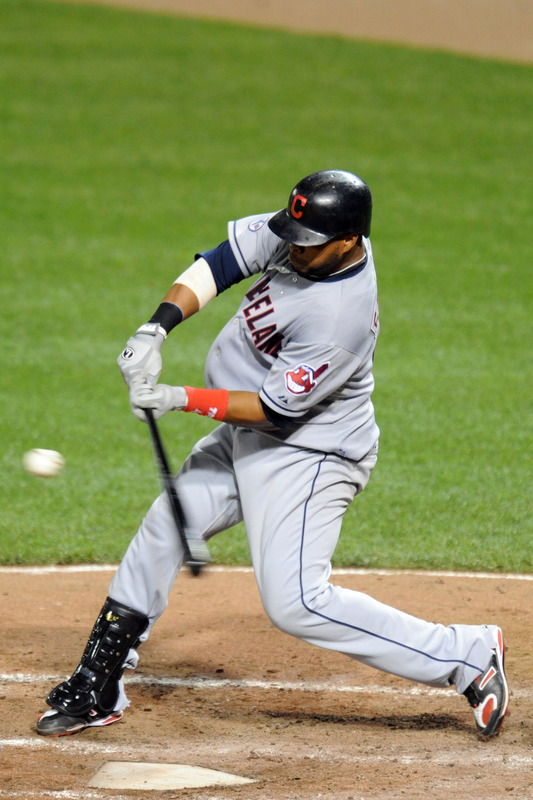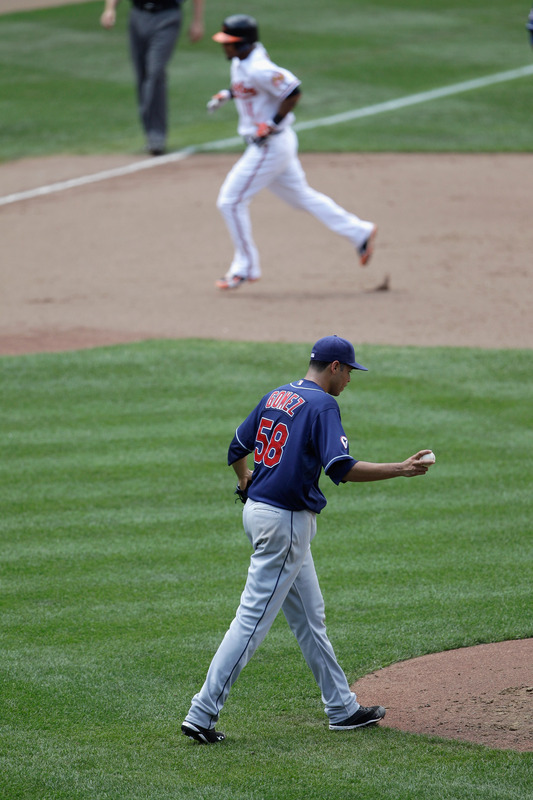 Indians Archive
Indians Archive  View from the Porch: Forecasting with Stats
View from the Porch: Forecasting with Stats
 As the Indians seesaw season continues, fans’ emotions go up and down like the coasters at Cedar Point. After playing like garbage at home against bottom feeders Kansas City and Minnesota, the Indians won two of three in Detroit and could have finished off a sweep with a couple timely hits in the series finale. May saw the Indians win six of eight, lose five of six, win eight of ten, and then lose five of six again.
As the Indians seesaw season continues, fans’ emotions go up and down like the coasters at Cedar Point. After playing like garbage at home against bottom feeders Kansas City and Minnesota, the Indians won two of three in Detroit and could have finished off a sweep with a couple timely hits in the series finale. May saw the Indians win six of eight, lose five of six, win eight of ten, and then lose five of six again.
Young teams are prone to inconsistency. Hitting is contagious and pitchers try to do too much to pick up their staff comrades or the slumping hitters. Nobody in the Central Division has played with any kind of consistency. The White Sox were beneficiaries of a period where they won 14 of 16 in late May and early June. Other than that stretch, they’re 18-23 for the season. The Tigers have clearly struggled, the Royals have been, admirably, digging out a 3-14 hole that they started the season in, and the Twins are awful.
Which leads me to this week’s View from the Porch topic. We’re all thinking it. Some days we are more optimistic about it. Some days we are more pessimistic. Some days, we have no idea what to believe. With one-third of the season in the books, what can we reasonably expect from the Indians and do they have the talent/luck/health/ability to win the Central Division? It all has to do with interpreting the statistics that the players have put up already and if we can expect unexpected contributions.
Let’s start with the lineup (stats through 6/7). The consensus opinion around TheClevelandFan.com is that Carlos Santana has to start hitting in the middle of the order for this team to have a chance. When you consider that Jose Lopez, who has already been designated for assignment once and was a minor league free agent signing in the offseason, is batting cleanup or fifth in your lineup, it’s clear that Santana has to produce.
 Through 46 games this year, Santana has a slash line of .232/.345/.363/.708. Through 46 games last season, coming back from the horrific knee injury he suffered in 2010, Santana had a slash line of .212/.347/.372/.719. Because Santana finished 2011 with a .239/.351/.457/.808 line, we can hope (and assume) that Santana will produce better from this point forward. Santana’s BABip, or batting average on balls in play (or, batting average taking strikeouts out of the equation), is .268, just one-one thousandth off of his .267 career. BABip is a measure of luck for a hitter. Santana is neither getting lucky nor unlucky.
Through 46 games this year, Santana has a slash line of .232/.345/.363/.708. Through 46 games last season, coming back from the horrific knee injury he suffered in 2010, Santana had a slash line of .212/.347/.372/.719. Because Santana finished 2011 with a .239/.351/.457/.808 line, we can hope (and assume) that Santana will produce better from this point forward. Santana’s BABip, or batting average on balls in play (or, batting average taking strikeouts out of the equation), is .268, just one-one thousandth off of his .267 career. BABip is a measure of luck for a hitter. Santana is neither getting lucky nor unlucky.
The biggest difference for Santana with his slugging percentage is the lack of home runs. Last season, Santana hit 21 of his 27 home runs after June 1. Many of Santana’s swing stats, like percentage of pitches swung at outside the strike zone, inside the strike zone, swinging strike percentage or contact percentage are all very similar to his career numbers.
Add all of that up and we can assume with reasonable confidence that Carlos Santana will get better and will be more of a run producer as the weather gets warmer, the ball carries more, and Santana gets a feel for his swing. Home runs and extra base hits are the byproduct of good swings and Santana hasn’t taken many of those this year. Last year, he proved to be a better second half hitter and a more consistent player. There’s no reason to believe this year should be any different.
Who else is underachieving? Well, I’m sure this will sound obvious, but Casey Kotchman is underachieving. The reason I bring him up is because there’s reason to believe that he will get significantly better as the season goes on. Kotchman put a horrendously bad April behind him by hitting a solid .276/.340/.379/.720 in May. It’s clearly far from ideal power production from a position like first base, but that’s more on par with Kotchman’s career statistics than April’s embarrassingly bad .149 average with a .494 OPS.
Here’s why Kotchman should get better. We all know the quality of his outs, so this is where the eye test devalues the statistics. Kotchman’s BABip is a paltry .228. That’s 50 points below his career of .277. Kotchman is striking out less than he had the previous two seasons and more contact should, theoretically, mean more base hits. For as bad as Kotchman has been offensively, his defensive contributions have kept him from being too far below replacement level. Baseball-Reference says that Kotchman is worth -.5 wins this season. So, for anybody saying that Kotchman is the problem, he really isn’t.
Kotchman has been insanely inconsistent over his career since his breakout year in 2007. In 2008, with Anaheim and Atlanta, Kotchman hit .272/.328/.410/.738. In 2009, with Atlanta and Boston, he put up a .268/.339/.382/.721. In 2010, with Seattle, he batted just .217/.280/.336/.616. In 2011, with Tampa, he broke out again with the bat batting .306/.378/.422/.800. With such variation, nobody is completely certain how productive he can be offensively, but the averages say that he should be closer to the 2008-2009 numbers than what he is currently hitting. That’s cause for optimism.
However, with the chances that Santana and Kotchman get better, is there somebody who is overachieving? It’s too early in Jason Kipnis’s career to tell if we can expect this kind of production to continue or not. The only question for him is if he can stay healthy. If he stays healthy, he has the opportunity to be as good or better than he currently is. His swing is quiet, meaning there’s very little movement and he’s short and quick to the baseball. That helps to avoid prolonged slumps. His effort is off the charts impressive.
The league average for BABip is between .290 and .310. Kipnis is currently at .300 even. A 20-30 point gap between BABip and batting average seems to be pretty standard. Kipnis’s falls right in that range. So, like Santana, he’s not getting lucky or unlucky. In theory, this means that his production should stay consistent like it is.
What about Asdrubal Cabrera? One of the things that has helped Asdrubal Cabrera immensely is that he’s not striking out near as much as he used to. Last season, Cabrera struck out 119 times. This year, he’s on pace to strike out 71 times, assuming 600 at bats. He’s swinging at fewer pitches out of the strike zone. Because of the low strikeout totals, Cabrera may be overachieving slightly in regards to BABip. It’s currently at .314, 18 points above his average. However, BABip assumes an average number of strikeouts. Cabrera’s is probably going to wind up below average for the season.
In summation, the Indians lineup really hasn’t reached its peak yet. Two key contributors are underachieving while the guys who are hitting should continue to produce at the same level that they are producing at. The big key is to stay healthy. That said, there’s still one gaping hole on the roster that may be too much for the rest of the hitters to overcome.
Left field has been a black hole of suck offensively for the Indians so far. The Indians left fielders on a given night have combined for, in 56 games, a .183/.286/.257/.544 slash line. That’s 37-for-202, 3 HR, 14 RBI, 1 SB, 30 BB, 47 K. Shelohnron Dumonham would be last in average, fourth-worst in OBP, last by 70 points in SLG, and last by nearly 60 points in OPS.
Is it possible to be a playoff team with a lineup spot as bad as that? I guess we’ll just have to find out.
 How about the pitching (stats through 6/7)? The regression train has run over Jeanmar Gomez, run over Derek Lowe, and is still on the prowl for more victims. Pitchers who don’t strike people out are bound to have problems throughout the season. BABip is also kept for pitchers. When people talk about pitcher regression, BABip is one of the numbers they’re keyed in on. There are certain factors to keep in mind, like a below average defense behind the pitcher or small sample sizes early in the year, but a lot of pitchers are pretty consistent with their BABips.
How about the pitching (stats through 6/7)? The regression train has run over Jeanmar Gomez, run over Derek Lowe, and is still on the prowl for more victims. Pitchers who don’t strike people out are bound to have problems throughout the season. BABip is also kept for pitchers. When people talk about pitcher regression, BABip is one of the numbers they’re keyed in on. There are certain factors to keep in mind, like a below average defense behind the pitcher or small sample sizes early in the year, but a lot of pitchers are pretty consistent with their BABips.
After getting knocked around a couple times recently, Derek Lowe’s once spectacular numbers are now far closer to they should be. Lowe now sits at 3.72 with his ERA and 3.95 with FIP, an ERA metric that removes subjective things like hits and BABip and measures a pitcher’s ERA by what he can control – walks, strikeouts, hit batters, and home runs.
Derek Lowe is very much in the ballpark of his career numbers. His 3.72 ERA is slightly below his 3.93 career ERA, but almost identical to his 3.79 career FIP. In other words, it is possible that Derek Lowe could continue this pace all season long. Keep in mind that some of his numbers are skewed because he spent time as a reliever. Lowe’s walks, which we were all concerned about early in the year, have now crept towards his career numbers. His 2.48 BB/9 is about on par with his 2.64 career. He’s still not striking hitters out and that’s the biggest worry. His career K/9 as a starter is somewhere around 5.5 strikeouts per nine innings. This year, he’s well below three strikeouts per nine innings.
It’s hard to summarize Derek Lowe just with the stats or the eye test. As long as he keeps giving up less home runs than his average and continues putting up a high ground ball rate to limit big innings and get double plays, he could be just fine.
Then, there’s the curious case of Justin Masterson. Masterson seemed to have a breakout season in 2011, cementing himself as the ace of the staff and a guy that the Indians could count on. In 2012, he’s been anything but an ace and been extremely unreliable.
Statistically, the problems for Masterson are very easy to see. He’s back to walking nearly 4.5 batters per nine innings and giving up more home runs. In 216 innings in 2011, Masterson gave up 11 home runs. In just 74.1 innings this year, he’d allowed six gopher balls. If we assume that Masterson will throw 200 innings this season, which would be an average of x per start, Masterson is on pace to walk 100 batters. Last season, he walked just 65. Thirty-five extra free baserunners is a sure-fire way to raise your ERA, especially when allowing more home runs.
Masterson hasn’t really given up more hits than last season’s pace and is on a similar path with his strikeout totals. His drop in velocity has increased the movement of his pitches and he has yet to harness and command them. He’s getting the same number of swings and misses, however, that may be from throwing a lot more sliders.
Masterson, like Santana, is a big worry. If he doesn’t play well from this point forward, it’s hard to imagine the Indians winning the division. With Santana, we can look for improvement because he has a bit of a track record of getting better as the season goes on and is on a similar path to his 2011 season. Masterson, on the other hand, got worse as the season wore on, including a 4.73 ERA in August and September.
Ubaldo Jimenez is probably a lost cause. Josh Tomlin is what he is. Jeanmar Gomez will give you an occasional good start but is likely going to struggle more often than not.
The Indians pitching staff, specifically Masterson, will decide if the Indians can be a division-winning, or even contending, team for the rest of the season.
- NBA Announces 2013-2014 Schedule
- Browns Ink Sharknado
- Sharknado A No-Show For Rookie Camp
- Trent Richardson Out Until Training Camp
- Browns Sign Brandon Jackson
- Carrasco Suspended Eight Games
- Browns Add to Wide Receiver Depth with David Nelson
- Browns Need to Learn from Past Draft Mistakes
- Browns Release Chris Gocong and Usama Young
- Browns Missing on Grimes Disappointing, But Not The End
The TCF Forums
- Chris Grant's first 3 drafts
Kingpin74 (Tuesday, January 21 2014 10:13 AM) - The 2014 Offseason Thread
googleeph2 (Tuesday, January 21 2014 9:36 AM) - 2015 Recruiting
furls (Tuesday, January 21 2014 6:57 AM) - Mike Brown
YahooFanChicago (Monday, January 20 2014 11:15 PM) - Movies coming out
HoodooMan (Monday, January 20 2014 9:34 PM) - 2014 Hoops Hockey Hijinx
jpd1224 (Monday, January 20 2014 4:44 PM) - 2014 Recruiting
jclvd_23 (Monday, January 20 2014 2:26 PM) - Wish List - #4 Pick
Hikohadon (Monday, January 20 2014 1:26 PM) - Official- Browns Coach Search/Rumors
OldDawg (Sunday, January 19 2014 6:48 PM) - #1 overall pick Anthony Bennett
TouchEmAllTime (Sunday, January 19 2014 1:28 PM)


